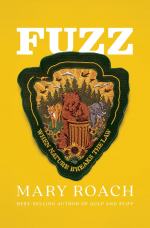|
This section contains 543 words (approx. 2 pages at 400 words per page) |

|
Fuzz: When Nature Breaks the Law Summary & Study Guide Description
Fuzz: When Nature Breaks the Law Summary & Study Guide includes comprehensive information and analysis to help you understand the book. This study guide contains the following sections:
This detailed literature summary also contains Topics for Discussion on Fuzz: When Nature Breaks the Law by Mary Roach.
The following version of this book was used to create the guide: Roach, Mary. Fuzz. Norton, 2022.
Mary Roach’s nonfiction text, Fuzz, explores human-wildlife interactions and questions how to contend with animals that seemingly break the law. At the outset of the book, the author examines incidents of animal induced fatalities and how humans approach these incidents in different parts of the world. In Aspen, Colorado she speaks with Stewart Breck about his work to mitigate bear activity within the populous alpine city. While bears are indigenous to the area, they are not natural predators of humans. However, the large animals enter the city in search for food, which is readily accessible when humans do not properly lock refuse receptacles and fail to sort recycling. While some agencies are more stringent in their adherence to fines, there is a general consensus that any bear involved in a human fatality will be killed. In “The Elephant in the Room”, Roach examines how animal induces human fatalities are handled in other parts of the world. In West Bengal, hundreds of humans are killed by elephants each year, but the government does not endorse culling the animals. The wildlife personnel work to redirect elephant behavior and recognize that humans are infringing on the animal's habitat which leads to instances of aggravation and vicarious death.
As Fuzz continues, Roach expands her research to examine deadly fauna. She visits Vancouver Island’s MacMillan Provincial Park to speak with tree assessors who cull detritus from the forest before it results in fatality. The assessors effectively accelerate the decomposition process in order to eliminate hazardous trunks and limbs that could fall on tourists. Later, the author examines the role of prototoxins in warfare and pest control. The Unites States military has experimented with poisons such as ricin to combat adversaries. When these experiments did not produce satisfactory results, they shipped their ricin caches to wildlife researchers for experimentation on rats. The author examines how the positioning of nature as an adversary leads to aggressive action against wildlife. Poisons continue to be used to contend with blackbirds eating sunflower farmers’ crops despite the known efficacy of non-lethal alternatives.
Later in the book, the author examines research into gene modification as a means of controlling natality rates in invasive species. In New Zealand, the government is committed to eradicating nonindigenous species, like rabbits and stoats that were introduced during colonization in the 1800s and have altered the indigenous flora and fauna populations. Researchers believe that genetic modification could reduce the population of invasive species more humanely and effectively than targeting mortality rates. Through experimentation on mice, they are developing a modification to ensure that all offspring is male. While this technique is optically acceptable when employed on invasive species, Roach questions who gets to decide what species these modifications are used on. She hypothesizes that this technology could lead to the extinction of an entire species in the same manner that unwitting introductions have in the past. Toward the close of Fuzz, Roach continues to promote cohabitation as the most effective and humane manner to approach human-wildlife encounters. She suggests that humans should adapt their own behavior to contend with flora and fauna instead of turning to annihilation and criminalization.
Read more from the Study Guide
|
This section contains 543 words (approx. 2 pages at 400 words per page) |

|



